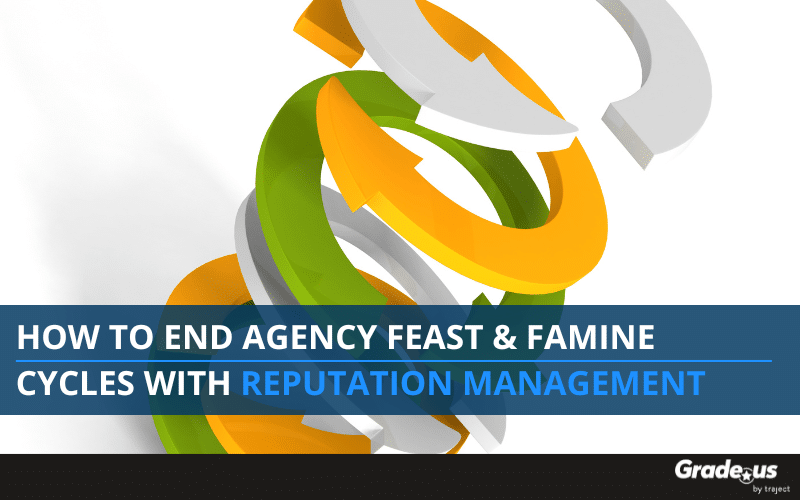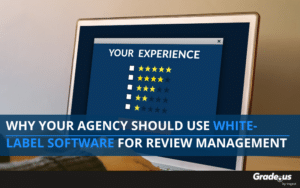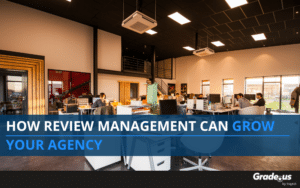Feast and famine cycles are a struggle for agencies.
When business is good, the agency grows; they’re forced to hire more staff as they win more clients. When clients move on, or they refuse to pay, agencies are forced to reduce their headcounts as they fight to survive.
It’s an exhausting ordeal.
These feast and famine cycles make it incredibly difficult to keep the doors open and the lights on. It becomes a difficult thing to keep talented employees, especially if they’re looking for career advancement and consistent growth.
You need a way out.
If your agency is going to survive over the long term, you need a way out. A way to end the feast and famine cycles for good; the question is how?
Ending agency feast and famine cycles for good
If we’re going to end feast and famine cycles for good, we’ll need a deeper understanding of what creates these cycles. If you have a clear understanding of these challenges, you’ll have the information you need to change these circumstances for good.
Let’s take a look at the causes.
- Not enough leads: You don’t have a consistent flow of clients who are interested in working with you. From an agency standpoint, this is tough for several reasons. (1.) The barriers to entry are low, so you’re forced to compete with one-person operations that promise the world, (2.) offshore competitors who offer lowball pricing, and (3.) established competitors who command more market share.
- Client non-payment: Your clients promise net 30 terms, but it becomes net 180 as your client works to avoid a cashflow crunch. Then, to complicate matters further, they ask for more work while promising to pay your outstanding invoices. So you can’t pursue new clients, and you aren’t getting paid for past and current work.
- No gateway services: Your services are all big ticket items that require a significant amount of agreement and lots of mental and emotional investment. Selling a $75K project is easier if you’ve already sold your clients on low cost, high-value work.
- Client churn: Your clients leave, and they take your income with them. If you’re used to receiving $225K in monthly income and that gets chopped in half, it can impact your ability to carry the expenses and continue to grow. Never mind that your expenses are always going up due to increased headcounts, insurance premiums, raises, and benefits. When clients leave, employees on these accounts need to be redeployed (profitably) or let go.
We know the cause.
How do we use this information to eliminate feast and famine cycles for good?
You already have the answer.
Look at the problem again. If we’re looking to eradicate feast and famine cycles, we need to:
Create a gateway service that generates leads, supplements your income (to offset client non-payment), and mitigates client churn.
What kind of gateway services do that?
- SaaS services
- Pay-per-lead services
- Reputation management services
There’s more, but these three services have a proven track record, and they’ve consistently created growth for agencies in various markets.
I’ve written about these before, but today we’ll look closely at item three.
Reputation management is the new gateway drug
What do I mean by ‘drug?’
I’m not minimizing addiction here. I’m talking about the kind of dependence clients have on the agencies that care for them. Because, let’s face it, many agencies fail to produce value for their clients.
That’s why reputation is the new gateway drug.
If you’re able to rally customers to your client’s business, generate leads on demand, or generate revenue for your clients, they’re not going to let you go. You’re simply too valuable for clients to leave behind.
Because online reviews open doors.
It’s something the vast majority of clients understand because they use reviews daily. It’s beneficial for your agency because it allows you to increase the value you can provide. You can win additional creative and development work on demand with the right account entry plan.
Here’s an example.
Step #01: You reach out to clients with negative reviews
Step #02: You agree to increase your client’s aggregate review rating and local rankings
Step #03: Clients receive better reviews, and local rankings
Step #04: You help clients boost their conversion rates, using their reviews to create winning ads and offers
Step #05: Clients receive more leads, customers, and revenue
Step #06: You convert client wins into more revenue and wins for your agency
This works like gangbusters…
But, it only works if you choose the right agency delivery model.
Do you have the right model? Your answer determines whether your agency will survive (or not). Most agencies get this answer wrong.
What’s so special about the delivery model?
Your delivery model dictates growth.
Most agencies follow the retainer/subscription model. They’re focused on producing significant work in exchange for a set monthly fee. Agencies scale up or down depending on client demands.
This makes sense.
The right delivery model gives your agency a plethora of benefits.
- Steady cash flow. With the right delivery model, your agency receives a consistent stream of cash. This enables you to negotiate from a position of strength.
- Predictability. A consistent delivery model is a predictable one. With the right model, you’ll be able to plan for the future. You have a better idea of when to push for growth. When to pursue loans or accept investment. When to hire and how many.
- A pricing framework you can use to increase profitability. You’ll have a better sense of when to increase your prices. You’ll be able to test your pricing safely, consistently boosting agency profits year-over-year.
- Projection accuracy. The right delivery model gives you the ability to make more accurate projections. It’s not a crystal ball by any means, but there’s more predictability than the traditional hourly model.
Here’s why this matters.
Reputation management services give you the opportunity to alter your agency’s delivery model. It gives you the chance to create legitimate demand for your other services
But it starts with you.
The ideal delivery model depends on you
What do you want?
Are you looking for a way to take fewer clients on but make more than you do now? Perhaps you’re looking for a way to pivot to a different service? Increase your prices?
What do you want from your agency?
It’s a good idea to approach this from two angles:
- The macro level: high-level goals, e.g., more time/freedom, making a difference, achieving prestige, etc. And…
- The micro level: 2x revenue, decrease expenses by 1/3, create monthly revenue from marketing that outpaces development work, etc.
Why go to the trouble?
It’s an easy way to improve your odds of success. Instead of guessing about your delivery model, you identify it by determining what you want first.
Make sense? Good.
Next, you’ll want to set some boundaries.
Ready?
How serious are you really? If you choose the managed services model, your clients will depend on you for everything.
I mean everything.
You’ll be expected to learn the product forwards and backwards if you’re full service. You’ll be expected to respond to reviews on your client’s behalf. It pays very, very well. It gives you the control you need to produce amazing results for your clients.
But it’s a lot of work.
Do you really want to slog through a consistent stream of comments and complaints for your clients?
Be honest with yourself.
Prefer to go the self-service route? This works well too. Create a strong marketing message that resonates with prospective clients, and you’ll attract a significant amount of self-service clientele.
Here’s the downside.
These clients aren’t especially loyal. Churn rates can be high, even if you do a fantastic job promoting your self-service option to needy clients.
Why?
Self-service depends entirely on your client’s ability. Your income is subject to their whims.
There’s danger here.
If clients give up, fail to produce the desired results, or can’t find the answer to their problems, you lose money. You lose money if they become bored or lose interest for any reason.
What does this mean?
You can never stop marketing. You’ll need to promote your services continually to outpace churn.
Did you catch that?
Every option has pros and cons, even if that means simply choosing to do nothing. If you decide with open eyes, you’re far more likely to weather the inevitable storms of the future.
You’ll need to set clear boundaries
Try not to be too restrictive.
Here’s the goal. You want to identify a delivery model that works best for your agency. If it’s too restrictive, you’ll struggle to get clients. Too broad, and you’ll attract and anger most of your clients.
Another thing.
At first glance, it looks like there are only two options here – managed or self-service. There are actually more than two options here.
- Managed services: You provide clients with full-service support for their review/reputation campaigns. This option is easy for most agencies to integrate.
- Self-service: A do-it-yourself option that empowers clients (especially those with a lower budget) to help themselves. You white-label a provider’s platform and then provide new and existing clients access.
- Managed to self-service: This option can be used in various ways. Three common approaches could be. (1.) A managed option that transitions to self-service once the campaign is stable and producing results. (2.) An agency can use the managed option to bring in much-needed revenue, then pivot to self-service once the client roster is mature. (3.) A semi self-service option that gives clients help on an as-needed, infrequent, or low-level basis.
- Self-service to managed: This option can be used in several creative ways. (1.) As an upsell for skeptical clients who are looking for help but prefer to start with self-service so they can better evaluate your performance. (2.) A loss leader agencies use to get their foot in the door with clients. This can be done via a free trial, compelling offer, or bonus.
- Managed + self-service. You allow your prospects to self-identify. They’re able to choose the service they want. You’re able to build a large audience and diversify your cash flow. You can use any of the options I’ve suggested above or come up with something new.
See what I mean?!
Let’s say you’ve identified a prospecting source. It’s filled with businesses that need your help. You send them a juicy email with this irresistible offer.
Subject: Uh oh, [Name], I found ## negative reviews about [company].
Body:
Hi [Name],
I noticed you’ve received [##] negative reviews in the last 48 hours. That’s going to show up in Google’s search results shortly. In a few hours, whenever someone searches for [Client]. They’re going to see these nasty reviews.
I can help you fix this.
My name is [Your Name], and I’m the [Title] of [Agency Name]. Here’s what I’m offering: Free access to our tool + instructions to fix this.
No obligation whatsoever.
Interested?
[Your name]
[Signature| LinkedIn| Direct Phone]
Are you seeing this?!
There are so many ways to pitch this. It’s a win for you! It’s a win for your clients!
Let’s break down the framework I used to create this pitch.
- Persuasive subject lines. You need to punch readers in the mouth, emotionally speaking. This is a serious problem. Their reputation is taking repeated hits. They need to do something. Now. If you’ve done your homework, this is no exaggeration.
- Problem. This is pretty obvious. Something is going wrong. Their biggest competitor just scored 60 reviews to their zero. They’ve received bad reviews. Customers are asking about them, but they’re nowhere to be found. Share a problem that (a.) commands immediate attention, (b.) is verifiable via a link, screenshot, video, etc.
- Urgency. Google is about to index this. Google has already indexed this. Their customers are talking about this. If you’ve selected the right problem and pre-qualified your prospect, they’re ready to act immediately. Help them understand the seriousness of their situation. Once these negative reviews gain traction, their conversion rates will begin to fall.
- Trust seals. Are you an online scammer? They don’t know! So you show prospects you’re legit. How? By sprinkling trust nuggets throughout your email (e.g. your name, agency, direct phone, LinkedIn, website, email, awards, accolades, etc.), anything that verifies your ability and status.
- Close. The close here is really, really simple. It’s so simple all your prospect has to do is type “Yes” and click send. It’s easy for them to say Yes or No. Both answers are fantastic. You win either way!
Simple, right?
Here’s the problem. This pitch won’t work. In fact, it’s going to fail.
How do I know?
We haven’t figured out what your clients want from you yet! That’s key. We really need to figure out what they what from you.
Alright. How do we do that?
Your clients need you to carry burdens
Your clients are struggling.
If they’re running a small business, they’re probably running from one fire to the next. Most are fighting desperately to keep their business open. There are too many things to do and not enough hands to do it. Maybe you know what that’s like?
They’re under a lot of pressure.
These business owners are exhausted, underpaid, overworked, and hanging on by a thread. Most of them are wearing multiple hats. This is why so many of them are short with you.
They have to be.
So, how do you get through to these prospects?
You demonstrate instant value. You don’t waste their attention, time, or money. Respecting their time alone will set you apart from your competitors.
These business owners are surrounded by knowledge vampires. People and institutions looking to take their:
- Time. Can I have free advice? Can I pick your brain? Will you mentor me? Give me free training?
- Money. Disrupting their precious yet unstable cash flow
- Resources – siphoning their connections, access, mentors, or ideas
It’s no surprise they’re always on guard. What does this mean for you?
You’ll be tested.
Prospects will use filters to determine whether you’re a taker or a giver.
Passing the test is easy.
Immediately and always provide value. Give and serve first before asking, taking, or receiving. It’s that simple. Present yourself as a taker, and you’ll find you’re immediately tossed aside.
Easier said than done.
How do you do that?
- Reach out to ideal clients/prospects in your target vertical.
- Request a lunch interview (lunch on you, of course). If you already have clients you love working with (and want more of), start there. Reach out to ideal prospects in your area if you’re just getting started.
- Interview them.
- Then, integrate the lessons you’ve learned from your interview.
Get their answers to these six distinct questions.
- What’s your business’ biggest problem(s)?
- How would your business be affected by a series of negative reviews?
- Would you look for help or attempt to fix the problem on your own?
- Would you be willing to pay for review management services?
- What would prevent you from buying review management services?
- What would you expect from this service? When? Why?
Look at your notes.
Compare and contrast your desires, goals, and problems with your prospect’s. Does anything stand out to you? Take the time you need. Study this carefully.
- Are there any conflicts?
- Any areas where expectations and circumstances align?
- Can you harmonize your desires and expectations with your prospect’s?
- Which areas are seemingly a no go?
Choose the option that best meets the requirements you’ve laid out.
This is how you do it.
This is how you choose the right delivery model for your agency. It’s also how you ensure that your pitch to prospects will be successful.
Wait a minute.
What if you choose the wrong delivery model?
It’s an easy fix.
You keep the clients you have, and you downgrade any troublesome clients to the new option by a particular date and time. Current clients are grandfathered in; new clients are offered the new terms and conditions you choose.
It’s still a win.
You choose the plan that works best for your agency, your clients receive the benefits of the services you provide.
Make sense?
The feast or famine rollercoaster is unsustainable
Most agencies lack stability.
They have more work than they can handle, or there’s not enough work to pay the bills. It’s a never-ending rollercoaster of stress and anxiety.
It’s an exhausting but unnecessary ordeal.
Your delivery model dictates growth.
Online reputation management is the gateway service that ends feast/famine cycles permanently. With the right delivery model, you’ll have the consistent income you need to attract a significant amount of traffic, leads, and sales.
You’ll get it all.
The predictability. The steady cash flow. A pricing framework to increase your revenue year-over-year. Protection from client churn and non-payment.
But it all starts with your delivery model.
Your delivery model depends on two ingredients – you and your clients.
Your agency will survive.
If you want to eliminate feast and famine cycles in your agency, you’ll need to apply the right strategies and tactics:
Create a gateway service that generates leads, supplements your income (to offset client non-payment), and mitigates client churn.
Choose SaaS, pay-per-lead, or reputation management services – any service that enables you to deliver quick wins at low cost to your clients. Choose your approach carefully, and you’ll find your feasts have replaced your famines.









